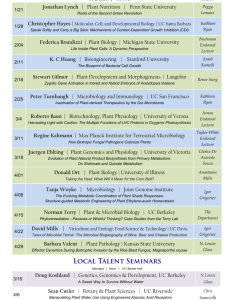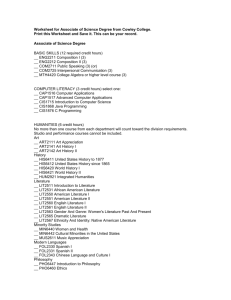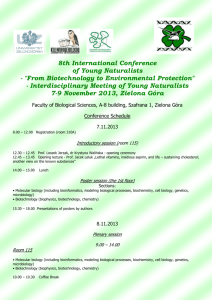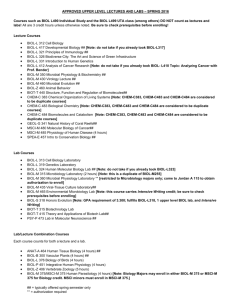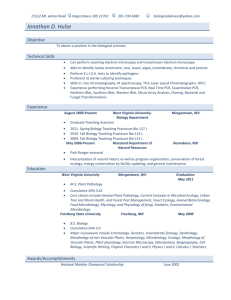Life Sciences
advertisement
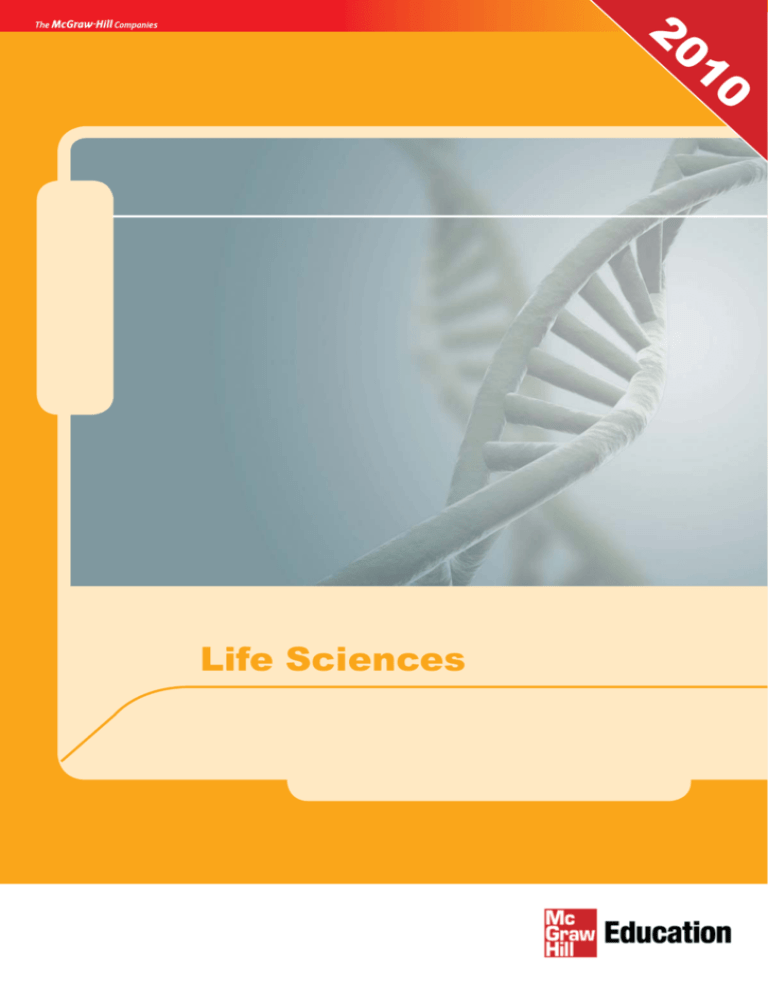
20 10 Life Sciences 1 Table of Contents NEW NEW NEW NEW NEW NEW NEW NEW NEW ARIS ..................................................................................................................1 Enger: Concepts in Biology, 13/e .......................................................................2 Johnson: Essentials of the Living World, 3/e .....................................................2 Mader: Essentials of Biology, 2/e .......................................................................2 Johnson: The Living World, 6/e .........................................................................3 Mader: Inquiry into Life, 13/e .............................................................................3 Mader: Human Biology, 11/e ..............................................................................4 Mader: Biology, 10/e ..........................................................................................5 Brooker: Biology, 2/e ..........................................................................................6 Raven: Biology, 9/e ............................................................................................7 McKinley: Human Anatomy, 2/e .........................................................................8 Saladin: Human Anatomy, 3/e ...........................................................................8 Fox: Human Physiology, 11/e ............................................................................9 Widmaier: Vander’s Human Physiology, 11/e ....................................................9 Gunstream: Anatomy & Physiology with Integrated Study Guide, 4/e .............10 Longenbaker: Mader’s Understanding Human Anatomy & Physiology, 7/e ....10 Shier: Hole’s Essentials of Human Anatomy & Physiology, 10/e .....................10 VanPutte: Seeley’s Essentials of Anatomy & Physiology, 7/e ..........................10 Shier: Hole’s Human Anatomy & Physiology, 12/e .......................................... 11 Saladin: Anatomy & Physiology, 5/e ................................................................ 11 VanPutte: Anatomy & Physiology, 9/e .............................................................. 11 Cowan: Microbiology, 2/e .................................................................................12 Talaro: Foundations in Microbiology, 7/e .........................................................12 Nester: Microbiology, 6/e .................................................................................12 Willey: Prescott’s Principles of Microbiology, 1/e .............................................13 Willey: Prescott’s Microbiology, 8/e .................................................................13 Molles: Ecology, 5/e .........................................................................................14 Cunningham: Principles of Environmental Science, 5/e ..................................15 Cunningham: Environmental Science, 11/e .....................................................15 Enger: Environmental Science, 12/e ...............................................................15 Other Texts from McGraw-Hill...........................................................................16 Presentation Center ..........................................................................................17 www.successinhighered.com We are pleased to announce the launch of the McGraw-Hill Higher Education Success sites. These sites will provide you with a consistent, one-stop shop, for finding new Science, Engineering, and Math titles, accompanying digital offerings, related marketing webinars/ events, and seasonal promotions. To checkout all subject-specific success sites, go to www.successinhighered.com and find out how you and your students can prepare for success in the course! Assessment, Review, and Instruction System, also known as ARIS, is an electronic homework and course management system designed for greater flexibility, power, and ease of use than any other system. Whether you are looking for a preplanned course or one you can customize to fit your course needs, ARIS is your solution. You may be asking yourself, “Why should I use an electronic homework system? Why ARIS? Simply stated, ARIS provides instructors with a complete course management freedom to: • Go beyond the limits of print: Students have 24-hour access to practice sets and smart tutorial feedback to master curricular goals. Some courses’ practice sets can be algorithmically generated providing virtually unlimited practice. Students also have access to animations, videos and simulations. • Spend more time teaching: Tired of spending most of your time creating and grading homework? With ARIS, building quizzes, homework assignments, tests, etc. is only a few clicks away. If you don’t want to create your own content you can also choose pre-built assignments or import content from other sources, including WebCT and Blackboard. And of course, assignments are automatically graded. You may never need to grade homework again! • Know exactly where your students stand: ARIS’ gradebook functionality is extremely versatile and allows you to manipulate data with different views and sorts to track student progress. View student scores in real-time, identify areas where they are struggling, and build your assignments and lecture accordingly. • Control the communication and content of your course: Enhance your communication with students via ARIS through posting announcements, attaching documents, hosting chat sessions, and email. Easily control the direction of your course and make sure other instructors, adjuncts, part timers, and TAs are “on the same page” by creating a master syllabus. www.mharis.com 1 Biology Concepts in Biology, 13/e Eldon D. Enger, Delta College Frederick C. Ross, Delta College David B. Bailey, Delta College www.mhhe.com/enger13e 2009 • 978-0-07-128789-0 • 704 pages Concepts in Biology, 13/e is a relatively brief introductory general biology text written for students with no previous science background. The text covers all the main areas of study in biology from cells through ecosystems. Evolution and ecology coverage are combined in Part Four to emphasize the relationship between these two main subject areas. Instructors will appreciate the book’s scientific accuracy, complete coverage and extensive supplement package. Essentials of the Living World, 3/e NEW George B. Johnson, Washington University Jonathan Losos, Washington University www.mhhe.com/esstlw3 2010 • 978-0-07-016776-6 • 704 pages A student favorite, this engaging text, now presented with a new single column format, is rich with student-oriented applications and illustrations that drive the learning. Written from scratch to be an appealing and accessible learning tool with an emphasis on “how things work and why things happen the way they do”, this Essentials text features a straightforward, clear writing style with ample use of analogies to help students relate new material to familiar things. NEW digital assets for the 3rd edition include high interest video clips and animations of key biological concepts. Essentials of Biology, 2/e Sylvia S. Mader www.mhhe.com/maderessentials2 2009 • 978-0-07-017227-2 • 672 pages Essentials of Biology, 2/e is an introductory biology text for non-major students that combines Dr. Sylvia Mader’s superb and accessible writing style with clear visuals, a comprehensive learning system, and abundant supplements. It explains the principles of biology clearly and illustrates them in a captivating, easy-to-understand manner. Essentials of Biology, 2/e emphasizes the relevance of biology to students’ lives within a framework of biodiversity and is organized around the major concepts of biology— cells theory, gene theory, evolution, the theory of homeostasis, and ecosystems. 2 Biology The Living World, 6/e George B. Johnson, Washington University Jonathan Losos, Washington University www.mhhe.com/tlw6 2009 • 978-0-07-016777-3 • 832 pages George Johnson has written this non-majors textbook from the ground up to be an engaging and accessible learning tool with an emphasis on “how things work and why things happen the way they do”. The Living World, 6/e focuses on concepts rather than terminology and technical information, and features a straightforward, clear writing style and a wide variety of media assets to enhance the content of the textbook. Table of contents 1: The Science of Biology 2: Evolution and Ecology 3: The Chemistry of Life 4: Molecules of Life 5: Cells 6: Energy and Life 7: Photosynthesis: Acquiring Energy from the Sun 8: How Cells Harvest Energy from Food 9: Mitosis 10: Meiosis 11: Foundations of Genetics 12: DNA: The Genetic Material 13: How Genes Work 14: Gene Technology 15: Genomics 16: The Revolution in Cell Technology 17: Evolution and Natural Selection 18: How We Name Living Things 19: The First Single-Celled Creatures 20: Advent of the Eukaryotes 21: Fungi Invade the Land 22: Evolution of Plants 23: Plant Form and Function 24: Plant Reproduction and Growth 25: Evolution of the Animal Phyla 26: History of the Vertebrates 27: How Humans Evolved 28: The Animal Body and How It Moves 29: Circulation 30: Respiration 31: The Path of Food through the Animal Body 32: Maintaining the Internal Environment 33: How the Body Defends Itself 34: The Nervous System 35: Chemical Signaling Within the Animal Body 36: Reproduction and Development 37: Ecosystems 38: Populations and Communities 39: Behavior and the Environment 40: Planet under Stress Inquiry into Life, 13/e NEW Sylvia S. Mader www.mhhe.com/maderinquiry13 2010 • 978-0-07-122038-5 • 832 page0s From the unique delivery of biology content, to the time tested art program, to the complete integration of the text with technology, Dr. Sylvia Mader has formed a teaching system that will both motivate and enable your students to understand and appreciate the wonders of all areas of biology. Inquiry into Life, 13/e emphasizes the application of all areas of biology to knowledge of human concerns, what the students are able to relate to. This distinctive text was developed to stand apart from all other non-majors texts with a unique approach, unparalleled art, and a straightforward, succinct writing style that has been acclaimed by both users and reviewers. Table of contents 1: The Study of Life Part 1: Cell Biology 2: The Molecules of Cells 3: Cell Structure and Function 4: Membrane Structure and Function 5: Cell Division 6: Metabolism: Energy and Enzymes 7: Cellular Respiration Part 2: Plant Biology 8: Photosynthesis 9: Plant Organization and Function 10: Plant Reproduction and Responses Part 3: Maintenance of the Human Body 11: Human Organization 12: Cardiovascular System 13: Lymphatic and Immune Systems 14: Digestive System and Nutrition 15: Respiratory System 16: Urinary System and Excretion Part 4: Integration and Control of the Human Body 17: Nervous System 18: Senses 19: Musculoskeletal System 20: Endocrine System Part 5: Continuance of the Species 21: Reproductive System 22: Development and Aging 23: Patterns of Inheritance 24: DNA Biology and Technology 25: Control of Gene Expression and Cancer 26: Genetic Counseling Part 6: Evolution and Diversity 27: Evolution of Life 28: Microbiology 29: Plants 30: Animals: Part I 31: Animals: Part II Part 7: Behavior and Ecology 32: Animal Behavior 33: Population Growth and Regulation 34: Nature of Ecosystems 35: The Biosphere 36: Environmental Concerns Supplements 978-0-07-729743-5 (Lab Manual) 3 Biology Human Biology, 11/e Sylvia S. Mader www.mhhe.com/maderhuman11e 2009 • 978-0-07-016778-0 • 608 pages This best-selling text introduces students to the anatomy and physiology of the human body and also discusses the relationship of humans to other living things. Human Biology, 11/e remains user friendly; relevancy and pedagogy are among its strengths. In this edition, as in previous editions, each chapter presents the topic clearly and distinctly so that students will feel capable of achieving an adult level of understanding. Detailed, highlevel scientific data and terminology are not included because Dr. Mader believes that true knowledge consists of working concepts rather than technical facility. Features • The Mader Author Story: Sylvia Mader is the subject matter expert and learning system architect in one. Dr. Mader represents the student by paging the book and striking the proper balance of art, photo, text, and application. Sylvia has taught millions of non-majors students the language of biology. Her teaching experience at Mass Bay CC is what led Sylvia to making the time to design her text layout specifically to the non-majors market. • Hallmark Writing Style: Dr. Sylvia Mader’s succinct, precise writing style is what has earned her a reputation as one of the most successful introductory biology textbook authors ever, and it is the most compelling feature of this text. • Updated Genetics Coverage: The entire genetics chapter has been updated to include the most recent information possible. This edition now combines genetics and genetic counseling topics in one chapter. • Human Disease Coverage Expanded: Human Disease coverage has been enhanced and is covered as each system is discussed. • ARIS: McGraw-Hill’s Assessment, Review, and Instruction System is a complete, online tutorial, electronic homework, and course management system, designed for greater ease of use than any other system available. • New Chapter Openers Throughout: Each chapter begins with an engaging, real-life vignette that captures the student’s attention. The vignette is referenced throughout the chapter with connections/applications woven into the chapter and finally at the end of the chapter students are asked to consider the vignette in light of the chapter concepts by discussing critical-thinking questions related to the chapter opener. Table of contents 1: Exploring Life and Science Part 1: Human Organization 2: Chemistry of Life 3: Cell Structure and Function 4: Organization and Regulation of Body Systems Part 2: Maintenance of the Human Body 5: Cardiovascular System: Heart and Blood Vessels 6: Cardiovascular System: Blood 7: Lymphatic System and Immunity 8: Digestive System and Nutrition 9: Respiratory System 10: Urinary System and Excretion Part 3: Movement and Support in Humans 11: Skeletal System 12: Muscular System Part 4: Integration and Coordination in Humans 13: Nervous System 4 14: Senses 15: Endocrine System Part 5: Reproduction in Humans 16: Reproductive System 17: Development and Aging Part 6: Human Genetics 18: Patterns of Chromosome Inheritance 19: Cancer 20: Patterns of Genetic Inheritance 21: DNA Biology and Technology Part 7: Human Evolution and Ecology 22: Human Evolution 23: Global Ecology 24: Human Population, Planetary Resources, and Conservation Supplements 978-0-07-723513-0 (Lab Manual) Biology Biology, 10/e Sylvia S. Mader www.mhhe.com/maderbiology10 2009 • 978-0-07-128886-6 • 1,024 pages Biology, 10/e is a comprehensive introductory biology textbook for non-majors or mixed-majors courses that covers biology in a traditional order from the structure and function of the cell to the organization of the biosphere. The book, which centers on the evolution and diversity of organisms, is appropriate for a one- or two-semester course. Sylvia Mader’s Biology, 10/e continues to be a text that’s appreciated as much by instructors as it is by the students who use it. Features • Visuals: The brilliant visual program of the previous edition is enhanced even more by the addition many new micrographs and innovative page layouts. • Animations: Approximately 70 animations of key biological processes accompany this tenth edition. • McGraw-Hill’s Biology Digitized Video Clips: Licensed from some of the highest-quality science video producers in the world, these brief segments range from 15 seconds to two minutes in length and cover all areas of general biology from cells to ecosystems. • All text, artwork, and photos necessary to understand a particular concept (e.g., prokaryotic vs. eukaryotic replication) appear either on the same page or facing pages. Table of contents 1: A View of Life Part 1: The Cell 2: Basic Chemistry 3: The Chemistry of Organic Molecules 4: Cell Structure and Function 5: Membrane Structure and Function 6: Metabolism: Energy and Enzymes 7: Photosynthesis 8: Cellular Respiration Part 2: Genetic Basis of Life 9: The Cell Cycle and Cellular Reproduction 10: Meiosis and Sexual Reproduction 11: Mendelian Patterns of Inheritance 12: Molecular Biology of the Gene 13: Regulation of Gene Activity 14: Biotechnology and Genomics Part 3: Evolution 15: Darwin and Evolution 16: How Populations Evolve 17: Speciation and Macroevolution 18: Origin and History of Life 19: Systematics and Phylogeny Part 4: Microbiology and Evolution 20: Viruses, Bacteria, and Archaea 21: Protist Evolution and Diversity 22: Fungi Evolution and Diversity Part 5: Plant Evolution and Biology 23: Plant Evolution and Diversity 24: Flowering Plants: Structure and Organization 25: Flowering Plants: Nutrition and Organization 26: Flowering Plants: Control of Growth Responses 27: Flowering Plants: Reproduction Part 6: Animal Evolution and Diversity 28: Invertebrates 29: Vertebrates 30: Human Evolution Part 7: Comparative Animal Biology 31: Animal Organization and Homeostasis 32: Circulation and Cardiovascular Systems 33: Lymph Transport and Immunity 34: Digestive Systems and Nutrition 35: Respiratory Systems 36: Body Fluid Regulation and Excretory Systems 37: Neurons and Nervous Systems 38: Sense Organs 39: Locomotion and Support Systems 40: Hormones and Endocrine Systems 41: Reproductive Systems 42: Animal Development Part 8: Behavior and Ecology 43: Behavioral Ecology 44: Population Ecology 45: Community and Ecosystem Ecology 46: Major Ecosystems of the Biosphere 47: Conservation of Biodiversi Supplements 978-0-07-296753-1 (Instructor’s Computerized Testing CD) 978-0-07-296752-4 (Transparencies) 978-0-07-297671-7 (Student Study Guide) 978-0-07-722617-6 (Lab Manual) 978-0-07-312155-0 (Biology Digitized Video Clips) 5 Biology NEW Biology, 2/e Robert J. Brooker, University of Minnesota Eric P. Widmaier, Boston University Linda E. Graham, University of Wisconsin Peter D. Stiling, University of South Florida www.mhhe.com/majorsbiology 2010 • 978-0-07-122180-1 • 1,440 pages The first edition of Brooker’s Biology has reached thousands of students and provided them with an outstanding view of the biological world. Now, the second edition has gotten even better! The author team is dedicated to producing the most engaging and current text that is available for undergraduate students who are majoring in biology. Features • Each chapter in the second edition begins with an interesting story or set of observations that will catch the students’ interests as they begin to read a chapter. • To help students test their knowledge and critical thinking skills, we have increased the number of Concept Check questions that are associated with the figure legends and revised the many of the questions at the end of each chapter so they are at a higher level in Bloom’s taxonomy. An answer key for the questions is now provided in an appendix at the end of the book. • To further help students appreciate the scientific process; the Feature Investigation in each chapter now includes three new elements: a Conclusion, the original journal citation for the experiment, and questions that are directly related to the experiment. • Many photographs and micrographs have been enlarged or replaced with better images. • The presentation of the material has been refined by dividing some of the chapters into smaller sections and by the editing of complex sentences. • The author team has worked with hundreds of faculty reviewers to refine and update the scientific content so that students are exposed to the most cutting edge material. • Outstanding Media: Connect: Enhanced Image and Lecture PowerPoints; New Animations; Active Learning Exercises. Learn: Engaging, Interactive Questions and Activities; Student Self Study. Succeed: Enhanced Test Bank; Powerful Diagnostics and Reports for Students and Instructors; Connect Plus eBook. Table of contents 1: An Introduction to Biology Unit 1: Chemistry 2: The Chemical Basis of Life I: Atoms, Molecules, and Water 3: The Chemical Basis of Life II: Organic Molecules Unit 2: Cell 4: General Features of Cells 5: Membrane Structure, Synthesis, and Transport 6: An Introduction to Energy, Enzymes, and Metabolism 7: Cellular Respiration, Fermentation, and Secondary Metabolism 8: Photosynthesis 9: Cell Communication 10: Multicellularity Unit 3: Genetics 11: Nucleic Acid Structure, DNA Replication, and Chromosome Structure 12: Gene Expression at the Molecular Level 13: Gene Regulation 14: Mutation, DNA Repair, and Cancer 15: The Eukaryotic Cell Cycle, Mitosis, and Meiosis 16: Simple Patterns of Inheritance 17: Complex Patterns of Inheritance 18: Genetics of Viruses and Bacteria 6 19: Developmental Genetics 20: Genetic Technology 21: Genomes, Proteomes, and Bioinformatics Unit 4: Evolution 22: The Origin and History of Life 23: An Introduction to Evolution 24: Population Genetics 25: Origin of Species and Macroevolution 26: Taxonomy and Systematics Unit 5: Diversity 27: Bacteria and Archaea 28: Protists 29: Plants and the Conquest of Land 30: The Evolution and Diversity of Modern Gymnosperms and Angiosperms 31: Fungi 32: An Introduction to Animal Diversity 33: The Invertebrates 34: The Vertebrates Unit 6: Plants 35: An Introduction to Flowering Plant Form and Function 36: Flowering Plants: Behavior 37: Flowering Plants: Nutrition 38: Flowering Plants: Transport 39: Flowering Plants: Reproduction Unit 7: Animals 40: Introduction to Animal Form and Function 41: Neuroscience I: Cells of the Nervous System 42: Neuroscience II: Evolution and Function of the Brain and Nervous Systems 43: Neuroscience III: Sensory Systems 44: The Muscular-Skeletal System and Locomotion 45: Nutrition, Digestion, and Absorption 46: Control of Energy Balance, Metabolic Rate, and Body Temperature 47: Circulatory Systems 48: Respiratory Systems 49: Excretory Systems and Salt and Water Balance 50: Endocrine Systems 51: Animal Reproduction 52: Animal Development 53: Immune Systems Unit 8: Ecology 54: An Introduction to Ecology and Biomes 55: Behavioral Ecology 56: Population Ecology 57: Species Interactions 58: Community Ecology 59: Ecosystems Ecology 60: Biodiversity and Conservation Biology Anatomy & Physiology Human Anatomy, 2/e Michael McKinley, Glendale Community College Valerie O’Loughlin, Indiana University www.mhhe.com/mckinley2 2008 • 978-0-07-128320-5 With its unrivaled art program and accessible writing style, Human Anatomy, 2/e stands apart from other anatomy texts. High-quality photographs paired with brilliantly rendered illustrations help students visualize, understand, and appreciate the wonders of human anatomy. Student-friendly Study Tips, Clinical View boxes, and progressive question sets motivate students to internalize and apply what they’ve learned. The second edition has been refined based on reviewer feedback to offer an even stronger version of this highly acclaimed textbook. Table of contents 1: A First Look at Anatomy 2: The Cell: Basic Unit of Structure and Function 3: Embryology 4: Tissue Level of Organization 5: Integumentary System Skeletal System 6: Cartilage and Bone Connective Tissue 7: Axial Skeleton 8: Appendicular Skeleton 9: Articulations Muscular System 10: Muscle Tissue and Organization 11: Axial Muscles 12: Appendicular Muscles 13: Surface Anatomy Nervous System 14: Nervous Tissue 15: Brain and Cranial Nerves 16: Spinal Cord and Spinal Nerves 17: Pathways and Integrative Functions 18: Autonomic Nervous System 19: Senses: General and Special 20: Endocrine System Cardiovascular System 21: Blood 22: Heart 23: Vessels and Circulation 24: Lymphatic System 25: Respiratory System 26: Digestive System 27: Urinary System 28: Reproductive System Human Anatomy, 3/e NEW Kenneth S. Saladin, Georgia College and State University www.mhhe.com/saladinha3 2010 • 978-0-07-122207-5 • 864 pages From the most pedagogically sound organization to the exceptional art, to the integration of text with technology, Saladin has formed a teaching system that will both motivate and enable students to understand and appreciate the wonders of human anatomy. This distinctive text was developed to stand apart from all other anatomy texts with an approach borne out of more than 30 years of teaching, unparalleled art, and a writing style that has been acclaimed by reviewers. Designed for a one-semester college anatomy course, Saladin requires no prior knowledge of chemistry or cell biology. Features • A number of pedagogical changes have been made to address the increasing trend toward assessment-driven teaching and instructor and institutional accountability. • Saladin has carefully evaluated content coverage throughout the book and pared back sections that included too much detail for the undergraduate level or too much physiology for the 1-semester anatomy course. • CONNECT—the future in online course management is here! Instructors can deliver assignments, quizzes, and tests easily online. Students have 24/7 online access to an eBook. Online study assets are specifically tied to every illustration in the textbook. Study-on-the-Fly downloadable art and audio files for students. Table of contents Part 1: Organization of the Body 1: The Study of Human Anatomy 2: Cytology. The Study of Cells 3: Histology. The Study of Tissues 4: Human Development Part 2: Support and Movement 5: The Integumentary System 6: Bone Tissue 7: The Axial Skeleton 8: The Appendicular Skeleton 9: Joints 8 10: The Muscular System-Introduction 11: The Axial Musculature 12: The Appendicular Musculature Atlas of Regional and Surface Anatomy Part 3: Integration and Control 13: Nervous Tissue 14: The Spinal Cord and Spinal Nerves 15: The Brain and Cranial Nerves 16: The Autonomic Nervous System and Visceral Reflexes 17: Sense Organs 18: The Endocrine System Part 4: Maintenance 19: The Circulatory System I-Blood 20: The Circulatory System II-The Heart 21: The Circulatory System III-Blood Vessels 22: The Lymphatic System and Immunity 23: The Respiratory System 24: The Digestive System 25: The Urinary System Part 5: Reproduction 26: The Reproductive System Anatomy & Physiology NEW Anatomy & Physiology with Integrated Study Guide, 4/e Stanley E. Gunstream, Pasadena City College www.mhhe.com/gunstream4 2010 • 978-0-07-728153-3 • 560 pages Designed for an introductory, one-semester course, the scope, organization, writing style, depth of presentation, and pedagogical aspects of this text have been tailored to meet the needs of students preparing for a career in allied health. This text does not assume any prior science knowledge and effectively presents students with the fundamentals of anatomy and physiology. It’s the only text available with a built-in study guide/workbook. NEW Mader’s Understanding Human Anatomy & Physiology, 7/e Susannah N. Longenbaker, Columbus State Community College www.mhhe.com/longenbaker7 2010 • 978-0-07-122201-3 • 512 pages Drawing on over twenty years of teaching experience, Sue Longenbaker writes for the next generation of students that will learn anatomy and physiology from this classic textbook. Hole’s Essentials of Human Anatomy & Physiology, 10/e David N. Shier, Washtenaw Community College Jackie L. Butler, Grayson County College Ricki Lewis, Contributing Editor, “The Scientist” www.mhhe.com/shieress10 2009 • 978-0-07-127121-9 • 640 pages It is designed for the one-semester anatomy and physiology course relevant to students pursuing careers in the allied health field. The unparalleled teaching system is highly effective in providing students with a solid understanding of the important concepts in anatomy and physiology. NEW Seeley’s Essentials of Anatomy & Physiology, 7/e Cinnamon L. VanPutte, Southwestern Illinois College Jennifer L. Regan, University of Southern Mississippi Andrew F. Russo, University of Iowa www.mhhe.com/seeleyess7 2010 • 978-0-07-122006-4 • 704 pages Designed for the one-semester course, Seeley’s Essentials of Anatomy and Physiology is written to allow instructors the ability to accomplish one overall goal: to teach the basics of anatomy and physiology while fostering the skill of problem solving. Through learning how to solve problems and think critically, students learn anatomy and physiology based on two themes: the relationship between structure and function, and homeostasis. 10 Anatomy & Physiology Hole’s Human Anatomy & Physiology, 12/e David N. Shier, Washtenaw Community College Jackie L. Butler, Grayson County College Ricki Lewis, Contributing Editor, “The Scientist” www.mhhe.com/shier12 2009 • 978-0-07-122009-5 • 1,056 pages Hole’s Human Anatomy and Physiology, 12/e was created for the introductory level student designed for the two-semester anatomy and physiology course relevant to students pursuing careers in the allied health field. Graphic representations review chapter concepts, make connections, and stress the “big picture” in learning and applying the concepts and facts of anatomy and physiology. This text uses the appropriate amount of clinical coverage to draw students into the material by showing readers relevance of information presented. Anatomy & Physiology: The Unity of Form and Function, 5/e Kenneth S. Saladin, Georgia College and State University www.mhhe.com/saladin5 2009 • 978-0-07-128341-0 • 1,248 pages This text requires no prior knowledge of college chemistry or cell biology, and is designed for the two-semester anatomy and physiology course. Ken Saladin weaves graceful descriptions of human anatomy and physiology processes together with carefully selected clinical applications and fascinating stories from the history of medicine and evolutionary medicine to create a multi-layered story about the human body. A consistent set of chapter learning tools helps students identify and retain key concepts while the stunning visual program provides a realistic view of body structures and processes. The fifth edition is further improved by a complete integration of the text with extensive digital teaching and learning tools. Seeley’s Anatomy & Physiology, 9/e NEW Cinnamon VanPutte, Southwestern Illinois College Jennifer Regan, University of Southern Mississippi Andrew F. Russo, University of Iowa www.mhhe.com/seeley9 2010 • 978-0-07-122210-5 • 1,248 pages This text is designed to help students develop a solid, basic understanding of anatomy and physiology without an encyclopedic presentation of detail. Great care has been taken to select important concepts and to perfectly describe the anatomy of cells, organs, and organ systems. The plan that has been followed for nine editions of this popular text is to combine clear and accurate descriptions of anatomy with precise explanations of how structures function and examples of how they work together to maintain life. 11 Microbiology Microbiology: A Systems Approach, 2/e Marjorie Kelly Cowan, Miami University of Ohio-Oxford Kathleen Park Talaro, Pasadena Area Community College www.mhhe.com/cowan2 2009 • 978-0-07-128777-7 • 896 pages Microbiology: A Systems Approach, 2/e is a non-majors microbiology textbook that has quickly become known for its unique organization, appealing writing style, and current medical applications. Cowan/Talaro utilizes an organ systems approach, but unlike any other book, this text first describes the clinical presentation (the particular set of symptoms) and then all of the organisms that could cause the symptom as opposed to just providing a long list of organisms to study. This treatment is unique and represents a real difference in the method of teaching microbiology. Foundations in Microbiology, 7/e Kathleen Park Talaro, Pasadena Area Community College www.mhhe.com/talaro7e 2009 • 978-0-07-128445-5 • 928 pages Written with the non-major/allied health student in mind, Foundations in Microbiology, 7/e offers an accessible writing style through the use of tools such as case files and analogies to thoroughly explain difficult microbiology concepts. Active learning is promoted via innovative features such as concept mapping and “Visual Understanding” questions (using art to make content connections between chapters). A taxonomic approach is used for the study of pathogens. Microbiology: A Human Perspective, 6/e Eugene W. Nester, University of Washington Denise G. Anderson, University of Washington C. Evans Roberts, Jr., University of Washington Martha T. Nester www.mhhe.com/nester6 2009 • 978-0-07-127039-7 • 928 pages Appropriate for the non-major/allied health student, this authoritative text carefully explains the fundamentals of microbiology, providing a general overview of the principles followed by more detailed explanations. With its clear and concise writing style, Microbiology: A Human Perspective, 6/e offers modern coverage on such topics as genomics, biofilms, and quorum sensing. A body systems approach is used in the coverage of diseases. 12 Microbiology Prescott’s Principles of Microbiology Joanne Willey, Hofstra University Linda Sherwood, Montana State University Chris Woolverton, Kent State University www.mhhe.com/prescottprinciples 2009 • 978-0-07-128367-0 • 960 pages Prescott’s Principles of Microbiology continues in the tradition of the market leading Prescott, Harley, and Klein’s Microbiology. The authors have presented a streamlined, briefer discussion of the broad discipline of microbiology and have focused on readability and the integration of several key themes with an emphasis on evolution, ecology and diversity throughout the text. To accomplish this, each chapter focuses on key concepts and includes only the most relevant, up-to-date examples. Table of contents Part 1: Introduction to Microbiology. 1: The History and Scope of Microbiology. 2: Microscopes and the Study of Microbial Structure. 3: Procaryotic Cell Structure and Function. 4: Eucaryotic Cell Structure and Function. 5: Viruses and Other Acellular Agents. Part 2: Microbial Nutrition, Growth, and Control. 6: Microbial Nutrition. 7: Microbial Growth. 8: Control of Microorganisms. Part 3: Microbial Metabolism. 9: Introduction to Metabolism. 10: Catabolism: Energy Release and Conservation. 11: Anabolism: The Use of Energy in Biosynthesis. Part 4: Microbial Molecular Biology and Genetics. 12: Genes: Structure, Replication, and Expression. 13: Regulation of Gene Expression. 14: Mechanisms of Genetic Variation. 15: Microbial Genomics. 16: Biotechnology and Industrial Microbiology. Part 5: The Diversity of the Microbial World. 17: Microbial Evolution, Taxonomy, and Diversity. 18: The Archaea. 19: The Deinococci and Gram-Negative Nonproteobacteria. 20: The Proteobacteria. 21: The Low G + C Gram-Positive Bacteria. 22: The High G + C Gram-Positive Bacteria. 23: Eucaryotic Microbes. 24: Viral Diversity. Part 6: Ecology and Symbiosis. 25: Biogeochemical Cycling and the Study of Microbial Ecology. 26: Microorganisms in Natural Environments. 27: Microbial Interactions. Part 7: Host Defenses. 28: Nonspecific (Innate) Host Resistance. 29: Specific (Adaptive) Immunity. Part 8: Microbial Diseases and their Control. 30: Pathogenicity of Microorganisms. 31: Antimicrobial Chemotherapy. 32: Clinical Microbiology and Immunology. 33: The Epidemiology of Infectious Disease. Part 9: Applied Microbiology. 34: Microbiology of Food. 35: Applied Environmental Microbiology Supplements 978-0-07-721296-4 (Instructor’s Testing Resource CD) Prescott’s Microbiology, 8/e NEW Joanne Willey, Hofstra University Linda Sherwood, Montana State University Chris Woolverton, Kent State University 2010 • 978-0-07-735013-0 • 1,152 pages The author team of Prescott’s Microbiology continues the tradition of past editions by providing a balanced, comprehensive introduction to all major areas of microbiology. Because of this balance, Microbiology is appropriate for microbiology majors and mixed majors courses. The new authors have focused on readability, artwork, and the integration of several key themes (including evolution, ecology and diversity) throughout the text, making an already superior text even better. Table of contents Part 1: Introduction to Microbiology. 1: The Evolution of Microorganisms and Microbiology. 2: Microscopy. 3: Bacteria and Archaea. 4: Eukaryotic Microbial Structure and Function. 5: Viruses and Other Acellular Infectious Agents. Part 2: Microbial Nutrition, Growth, and Control. 6: Microbial Nutrition. 7: Microbial Growth and Reproduction. 8: Control of Microorganisms in the Environment. Part 3: Microbial Metabolism. 9: Introduction to Metabolism. 10: Catabolism: Energy Release and Conservation. 11: Anabolism: The Use of Energy in Biosynthesis. Part 4: Microbial Molecular Biology and Genetics. 12: Genes: Structure, Replication, and Expression. 13: Regulation of Cellular Processes. 14: Mechanisms of Genetic Variation. 15: Recombinant DNA Technology. 16: Microbial Genomics. Part 5: The Diversity of the Microbial World. 17: Microbial Taxonomy and the Evolution of Diversity. 18: The Archaea. 19: The Deinococci and Nonproeobacteria Gram Negatives. 20: The Proteobacteria. 21: The Low G + C Gram-Positive Bacteria: The Firmicutes. 22: The High G + C Gram-Positive Bacteria: The Actinobacteria. 23: The Protists. 24: The Fungi. 25: The Viruses. Part 6: Ecology and Symbiosis. 26: Biogeochemical Cycling. 27: Methods in Microbial Ecology. 28: Microorganisms in Marine and Freshwater Ecosystems. 29: Microorganisms in Terrestrial Ecosystems. 30: Microbial Interactions. Part 7: Pathogenicity and Host Response. 31: Infection and Pathogenicity. 32: Nonspecific (Innate) Host Resistance. 33: Specific (Adaptive) Immunity. Part 8: Microbial Diseases, Detection, and their Control. 34: Antimicrobial Chemotherapy. 35: Clinical Microbiology and Immunology. 36: Epidemiology and Public Health Microbiology. 37: Human Diseases Caused by Viruses and Prions. 38: Human Diseases Caused by Bacteria. 39: Human Diseases Caused by Fungi and Protists. Part 9: Applied Microbiology. 40: Microbiology of Food. 41: Industrial Microbiology. 42: Applied Environmental Microbiology Supplements 978-0-07-729281-2 (Lab Manual) 13 Environmental Science Principles of Environmental Science: Inquiry and Applications, 5/e William P. Cunningham, University of Minnesota Mary Ann Cunningham, Vassar College www.mhhe.com/cunningham5e 2009 • 978-0-07-128448-6 • 448 pages Rather than the 25 to 30 chapters found in most environmental science textbooks, the authors have limited Principles of Environmental Science, 5/e to 15 chapters--perfect for the one-semester, non-majors environmental science course. True to its title, the goal of this concise text is to provide an up-to-date, introductory view of essential themes in environmental science along with offering students numerous opportunities to practice scientific thinking and active learning. Environmental Science: A Global Concern, 11/e NEW William P. Cunningham, University of Minnesota Mary Ann Cunningham, Vassar College www.mhhe.com/cunningham11e 2010 • 978-0-07-017167-1 • 640 pages Environmental Science: A Global Concern, 11/e is a comprehensive presentation of environmental science for non-science majors which emphasizes critical thinking, environmental responsibility, and global awareness. This book is intended for use in a one- or two-semester course in environmental science, human ecology, or environmental studies at the college or advanced placement high school level. Table of contents 1: Understanding Our Environment 2: Principles of Science and Systems 3: Matter, Energy, and Life 4: Evolution, Biological Communities, and Species Interactions 5: Biomes: Global Patterns of Life 6: Population Biology 7: Human Populations 8: Environmental Health and Toxicology 9: Food and Hunger 10: Farming: Conventional and Sustainable Practices 11: Biodiversity: Preserving Species 12: Biodiversity: Preserving Landscapes 13: Restoration Ecology 14: Geology and Earth Resources 15: Air, Weather, and Climate 16: Air Pollution 17: Water Use and Management 18: Water Pollution 19: Conventional Energy 20: Sustainable Energy 21: Solid, Toxic, and Hazardous Waste 22: Urbanization and Sustainable Cities 23: Ecological Economics 24: Environmental Policy, Law, and Planning 25: What Then Shall We Do? Environmental Science: A Study of Interrelationships, 12/e Eldon D. Enger, Delta College Bradley F. Smith, Western Washington University www.mhhe.com/enger12e 2009 • 978-0-07-017166-4 • 512 pages This full-color, introductory environmental science text is known for being concise and conceptual. The approach and reading level cover the basic concepts without overloading students with too much detail. The authors reinforce the text’s central theme of “interrelationships” by providing a historical perspective, information on economic and political realities, discuss the role of different social experiences, and integrate this with the crucial science to describe the natural world and how we affect it. 15 Environmental Science Other Texts from McGraw-Hill Medical College of Ohio: Anatomy & Physiology Revealed Version 2.0 CD NEW NEW Hickman: Integrated Principles of Zoology, 15/e www.apreavealed.com 2008 • 978-0-07-337807-7 www.digitalzoology.com 2010 • 978-0-07-122198-6 • 896 pages Brooker: Genetics, 3/e Roberts: Foundations of Parasitology, 8/e www.mhhe.com/ brookergenetics3e 2009 • 978-0-07-128764-7 • 864 pages www.mhhe.com/ robertsjanovy8e 2009 • 978-0-07-131103-8 • 728 pages Lewis: Human Genetics, 9/e NEW Pechenik: Biology of the Invertebrates, 6/e www.mhhe.com/ lewisgenetics9 2010 • 978-0-07-122004-0 • 512 pages www.mhhe.com/ pechenik6e 2010 • 978-0-07-127041-0 • 624 pages Weaver: Molecular Biology, 4/e Kardong: Vertebrates, 5/e www.mhhe.com/weaver4 2008 • 978-0-07-127548-4 • 912 pages www.mhhe.com/ kardong5e 2009 • 978-0-07-128459-2 • 800 pages Bidlack: Stern’s Introductory Plant Biology, 12/e www.mhhe.com/ stern12e 2010 • 978-0-07-122212-9 • 640 pages NEW NEW Miller: Zoology, 8/e www.mhhe.com/ millerharley8e 2010 • 978-0-07-016483-3 • 608 pages NEW Wardlaw: Contemporary Nutrition, 8/e www.mhhe.com/ wardlawcont8 2010 • 978-0-07-122214-3 • 768 pages Byrd-Bredbenner: Wardlaw’s Perspectives in Nutrition, 8/e www.mhhe.com/ wardlawpers8 2009 • 978-0-07-128446-2 • 960 pages 16 Presentation Center Build your instructional materials wherever, whenever, and however you want! Presentation Center is an online digital library containing assets that can be used to create customized lecturers, visually enhanced tests and quizzes, compelling course websites, or attractive printed support materials. These assets are such as: • Active Art (a multiple-slide PowerPoint of one editable image) • Animations (including Quicktime, Flash, and other file formats) • Art (line art and illustrations) • Base Maps • Equations (mathematical equations saved as images) • Image PowerPoint (a PowerPoint containing all images from a chapter of the text) • Lecture PowerPoint (a PowerPoint containing images from a chapter and lecture notes) • Photos • Tables (taken from the text) • Text edit art (a single-slide PowerPoint with editable image labels) • Videos • Worked Examples (mathematical or textual examples taken from the text) Access to your book, access to all books! This ever-growing resource gives instructors the power to utilize assets specific to their adopted textbook as well as content from other McGraw-Hill books in the library. Presentation Center’s dynamic search engine allows you to explore by discipline, course, textbook chapter, asset type, or keyword. Simply browse, select, and download the files you need to build engaging course materials. All assets are copyrighted by McGraw-Hill Higher Education. 17 Middle East & Africa Aly Mahmoud (Egypt, Libya, Morocco & Tunisia) aly_mahmoud@mcgraw-hill.com Mobile: 0020 1 23161795 Tel. /Fax: 0020 2 24534178 Mohamed Shawky (Egypt, Libya, Morocco & Tunisia) mohamed_shawky@mcgraw-hill.com Mobile: 0020 1 80603886 Tel. /Fax: 0020 2 22705305 Haluk Baykara (Turkey, North Cyprus & Israel) haluk_baykara@mcgraw-hill.com Mobile: 0090 532 3514194 Tel.: 0090 312 2381369 Fax: 0090 312 2381395 Sevcan Karababa (Turkey & North Cyprus) sevcan_karababa@mcgraw-hill.com Mobile: 0090 533 3503378 Tel: 0090 312 4176458 Fax: 0090 312 4176459 Faris Bukhari (Jordan, Lebanon, Syria & Palestine) faris_bukhari@mcgraw-hill.com Tel: 00962 777 44 7676 Hassan Zaza (U.A.E. & Gulf States) hassan_zaza@mcgraw-hill.com Mobile: 00971 506534623 Tel.: 00971 43913171 Fax: 00971 43918005 Shirine Habash (U.A.E. & Gulf States) shirine_habash@mcgraw-hill.com Mobile: 00971 509034491 Tel.: 00971 43913171 Fax: 00971 43918005 Hussein Al-Qadi (Saudi Arabia & Yemen) hussein_alqadi@mcgraw-hill.com Mobile: 009665 0 4630149 Tel. /Fax: 009661 4 742447 Tony Moggach IMA (Africa) tony.moggach@moggach.demon.co.uk Tel.: 0044 20 72678054 Fax: 0044 20 74240034/74858462 Joseph Makope IMA (Africa) joseph@intermediaafrica.co.uk Tel.: 00234 8089539358 / 0044 20 72678054 Fax: 0044 20 74240034/74858462 Behruz Neirami (Iran) behruzn@neda.net.ir Tel.: 0098 2188748554 Fax: 0098 2188745894 Marketing Managers, MEA Wissam Al-Sha’ar Science, Engineering & Mathematics wissam_alshaar@mcgraw-hill.com Mobile: 00961 3 849458 Tel. /Fax: 00961 5 410748 Taline Prescott-Decie Business, Humanities & Social Sciences taline_prescott-decie@mcgraw-hill.com Mobile: 00961 3 326143 Tel. /Fax: 00961 4 401579 ™ www.mcgrawhillcreate.com Craft your teaching resources to match the way you teach! McGraw-Hill Education offers a variety of content solutions to help lecturers create a customized text closely matching their syllabus and students’ ability. Find Search across and within 3 million pages of content. Full text search across all McGraw-Hill resources. Specialized search filters—by discipline, by copyright, etc. Arrange Rearrange chapters, combine content from multiple sources, and even upload your own content. Personalize Select your cover, add your course information, and choose either an eBook or a print book for your students. *Receive a FREE PDF review copy in minutes! Create your ideal text by: • Combining content from more than one McGraw-Hill textbook • Deleting the content you do not cover • Including special readings and cases • Adding your syllabus, lecture notes and university logo • Joining the text and study guide in one book And, this time, add a subject-specific glossary translated in your local language! Greece, Cyprus & Malta Yiannis Plessas Sales Manager yiannis_plessas@mcgraw-hill.com Mobile: 0030 6945339755 Tel.: 0030210 6560990 Fax: 0030210 6545525 Eastern Europe Marek Lewinson mlewinso@it.com.pl Mobile: 0048 602 707037 Tel. /Fax: 0048 22 6714819 Radek Janousek radek@mareklewinson.com Mobile: 00420 602 294014 Register TODAY and see how McGraw-Hill Create™ allows you to teach your students, your way! Need help getting started? Contact your representative or our Editorial Department: Tanja Radivoevska tanja_radivoevska@mcgraw-hill.com Tel.: 0030210 6560990 Fax: 0030210 6545525

